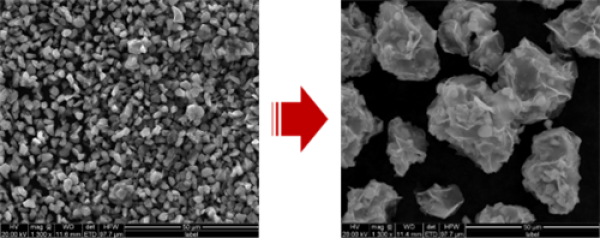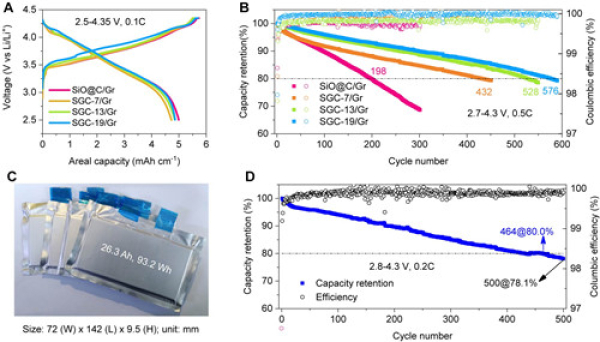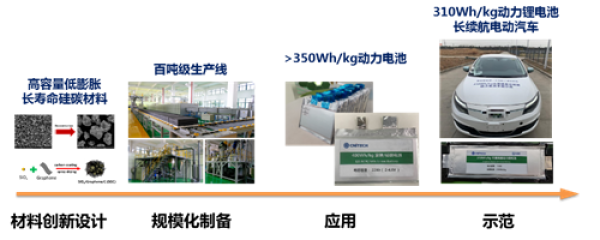2021-04-20


Figure 1 Preparation of graphene composite silicon carbon anode material with self mechanical inhibition

Figure 2 The first charge discharge curve (a) and cycle performance (b) of the flexible battery after the combination of different graphene modified negative electrodes and graphite; Photo of 353w/kg soft pack battery (c) and long cycle stability (d)

Figure 3 Innovative design, large-scale preparation, application research and application demonstration of graphene composite silicon carbon anode materials
Power batteries, consumer batteries and other end products have an increasing demand for high-energy density lithium-ion batteries. At present, the industry mainly adopts the silicon carbon composite route to improve the application level of silicon-based anode. Silicon carbon composite anode materials below 450mah/g can basically meet the application requirements in terms of circularity, magnification and so on. There are still technical difficulties in the application of silicon-based anode above 450mah/g. The volume expansion of high specific capacity silicon carbon anode material during lithium insertion / de lithium process is huge, and the structural failure of active materials will occur during the cycle, resulting in poor electrical contact, repeated rupture / regeneration of surface solid electrolyte membrane (SEI membrane), resulting in rapid consumption of electrolyte and rapid decline of reversible capacity of lithium-ion batteries. Therefore, the development of silicon carbon composite anode materials with high specific capacity and long cycle stability is full of challenges.
Aiming at the problem of volume expansion of silicon carbon anode materials, the Liu Zhaoping team of Ningbo Institute of materials technology and engineering, Chinese Academy of Sciences, started from the source to build a highly mechanically stable self mechanically suppressed graphene composite silicon carbon anode material(Energy Storage Materials2021, 35, 317-326.)。 Because the reversible capacity of silicon-based anode materials is linear with volume expansion, the reversible capacity of silicon-based anode materials can be effectively controlled by mechanically limiting the volume expansion. Graphene is known to have the highest mechanical properties, with an elastic modulus of 1 TPA, a yield strength of 130gpa, and a fatigue life of more than 10 under 71gpa loadnineSecondly, graphene exhibits elastic hardening during lithium intercalation. However, the weak adhesion between graphene sheets is weak, and the mechanical strength of graphene's macro structure is poor. Asphalt cracked carbon can effectively suture graphene, significantly improving the mechanical stability of graphene's macro body. As shown in Figure 1, silicon oxide (SiOx)And graphene slurry are evenly mixed in the liquid phase system, in which asphalt is used as an additive to prepare spherical graphene / asphalt pyrolysis carbon encapsulated silicon oxide composite cathode material (SIO) through a series of processes such as spray drying, high temperature heat treatment and chemical vapor depositionx/Graphene/c, SGC for short). The carbon atoms in graphene are arranged in a two-dimensional layered structure, which has good flexibility. At the same time, the van der Waals force between graphene layers is weak, which is prone to slip under stress, and has a certain elastic strain capacity; The pitch cracked carbon on the surface of graphene has an amorphous structure, and the rigid carbon carbon chemical bond has high tensile strength, which can maintain the integrity and mechanical stability of the macro structure of graphene.
The results show that the conductivity of sGC cathode modified by graphene can be increased by more than 2 orders of magnitude; When the content of graphene is ≥ 7wt%, the lubrication of graphene is conducive to improving the compaction density of powder. SiOxIntrinsic reversible lithium removal capacity and LixThe analysis of the relative content of Si shows that the SGC composite anode can significantly regulate SiOxLithium intake, more graphene content, SiOxThe lower the reversible capacity. The intercalation and de lithium behavior of graphene is affected by SiOxThe stress effect caused by volume expansion during charging and discharging. In conclusion, SGC composite anode material can inhibit SiOxLithium intake, reduce volume expansion and improve cycle stability. As shown in Figure 2, the compound capacity of different graphene modified silicon carbon composite anodes and graphite is about 850mah/g, and the first reversible capacity of soft packed batteries is about 5.0mah/cmtwoUnder the conditions of 0.5c cycle and 80% capacity cut-off, the cycle life is increased from 198 times to 576 times. Even under extreme cell preparation conditions, the 500 cycle capacity retention rate of 353wh/kg soft packed battery can still reach 78.1%.
With the support of the Chinese Academy of Sciences' science and technology service network plan (STS) "graphene industrialization application technology research and application demonstration" project (the implementation period is from January 2019 to December 2020, as shown in Figure 3), the research team further solved the technical problems of large-scale preparation of graphene composite silicon carbon cathode materials, and built a 100 ton pilot production line of graphene composite silicon carbon cathode materials relying on Ningbo Fuli battery materials technology Co., Ltd. Using this high-performance graphene composite silicon carbon cathode material, a series of new high-energy density lithium-ion batteries with an energy density of 350-400wh/kg were further developed, and won the first prize of the long cycle life high-energy density lithium ion battery extreme challenge competition in the 2020 future energy storage technology innovation idea solicitation and challenge competition; Jointly developed and realized 310wh/kg power battery loading application demonstration with Kunshan juchuangxin Energy Technology Co., Ltd. under Baoneng group. Recently, the science and technology promotion and Development Bureau of the Chinese Academy of Sciences organized the final acceptance of the STS project.
Article source:Battery net
0755-89480969
info@powercome.hk
B1202, building 1, Mogen Fashion Industrial Park, No. 10, shilongzi Road, Xinshi community, Dalang street, Longhua District, Shenzhen
www.powercome.hk